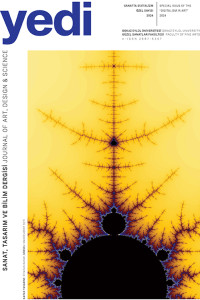Öz
Başlangıçta bilimsel bir çerçevede değerlendirilen holografi zamanla sanatsal alanda da kabul görmüştür. Holografiyi uzay, zaman, hareket ve ışık gibi temaları keşfetmek için kullanan sanatçılar sayesinde sanat eserlerindeki görsel derinlik katmanı arttırılmıştır. Bu kullanım, sanat eserlerine üç boyutlu bir etki kazandırarak, izleyicilere daha dinamik ve etkileşimli bir deneyim sunmaktadır. Holografik sanat, bu sayede hem estetik hem de kavramsal olarak zenginleşmekte, sanatın ve teknolojinin kesiştiği noktada ortaya yeni ifade biçimleri ve anlatım olanakları çıkarmaktadır. Çalışma kapsamında, hala gelişmekte olan bir alan olarak holografinin, sanat pratikleri ve teknolojik gelişmeler ışığında iki ve üç boyut arasındaki sınırları ortadan kaldırma biçimlerinin araştırılması amaçlamaktadır. Nitel araştırma yöntemiyle gerçekleştirilen araştırmada verileri elde etmek üzere holografinin bir sanat formu olarak çıkış̧ noktası olan 1960’lı yıllardan günümüze kadar süregelmiş̧ önemli çalışmalar hem sanat hem de teknoloji çerçevesinde geniş̧ bir literatür taraması ve doküman incelemesi yapılarak incelenmiş̧; ulusal ve uluslararası tezler, kitaplar, makaleler ve internet kaynakları araştırma referansları olarak kullanılmıştır.
Anahtar Kelimeler
Kaynakça
- Alam, S., Bellini, H., Chen, W., Shin, M., Sugiyama, M. ve Takayama, D. (2016). Profiles in innovation: Virtual & augmented reality. Understanding the race for the next computing platform. Goldman Sachs Research.
- Benyon, M. (1973). Holography as an art medium. Leonardo, 6(1), 1-9.
- Coyle R. (1990). Holography: Art in space of technology. Hayward, P. (Ed. Culture, technology and creativity in the late twentieth century (s. 65-88) içinde. John Libbey/Arts Council of Great Britain.
- Frayne, S. (2019, Eylül 17). Holograms, VR, AR and the future of reality. Looking Glass Blog. https://lookingglassfactory.com/blog/holograms-vr-ar-and-the-future-of-reality
- Holden, C. (1979). Holoart: Playing with a budding technology. Science, 204(4388), 40-41.
- HoloCenter. (t.y.). Different types of hologramms. https://holocenter.org/what-is-holography/different-types-of-holograms
- Holophile. (t.y.). The history of holography. http://www.holophile.com/history.htm
- Holos Gallery. (t.y.). About holos gallery. Gary Zellerbach. https://www.garyzellerbach.com/HGO/abouthg.html
- Integraf. (1973, Ocak). Dr. Tung J. Jeong biography. Integraf. https://www.integraf.com/about/tung-h-jeong
- Kurzen, A. (1983). Holographic stereograms in assemblage. Leonardo, 16(1), 10-14.
- Lightfoot, D. (1989). Contemporary Art-World Bias in regard to display holography: New York City. Leonardo, 22(3/4), 419-423.
- MIT Museum, (t.y.). Holography: The Light Fantastic. http://web.mit.edu/museum/exhibitions/holography-thelight-fantastic.html
- Nicholson, A. M. (1989). Some thoughts on holographic portraiture. Leonardo, 22(3), 369-373.
- Sapan, J. (2020, Haziran 9). How to make a single beam reflection hologram. Holographer. https://www.holographer.com/single-beam-reflection-holograms/
- Yamada, S., Kakue, T., Shimobaba, T. ve Ito, T. (2018). Interactive holographic display based on finger gestures. Scientific Reports, 8(1), 1-7. https://doi.org/10.1038/s41598-018-20454-6
Öz
Initially evaluated within a scientific framework, holography has gradually gained acceptance in the artistic sphere as well. Artists who utilize holography to explore themes such as space, time, movement, and light have enhanced the visual depth layer in art pieces. This application endows artworks with a three-dimensional effect, offering viewers a more dynamic and interactive experience. Holographic art has thus been enriched both aesthetically and conceptually, producing new forms of expression and narrative possibilities at the intersection of art and technology. This study aims to investigate, in light of art practices and technological advancements, how holography, as an evolving field, blurs the boundaries between two and three dimensions Conducted through qualitative research methods, the study examines the trajectory of holography as an art form from its inception in the 1960s to the present day, through an extensive literature review and document analysis encompassing both art and technology; and national and international theses, books, articles, and online resources have been employed as research references.
Anahtar Kelimeler
Kaynakça
- Alam, S., Bellini, H., Chen, W., Shin, M., Sugiyama, M. ve Takayama, D. (2016). Profiles in innovation: Virtual & augmented reality. Understanding the race for the next computing platform. Goldman Sachs Research.
- Benyon, M. (1973). Holography as an art medium. Leonardo, 6(1), 1-9.
- Coyle R. (1990). Holography: Art in space of technology. Hayward, P. (Ed. Culture, technology and creativity in the late twentieth century (s. 65-88) içinde. John Libbey/Arts Council of Great Britain.
- Frayne, S. (2019, Eylül 17). Holograms, VR, AR and the future of reality. Looking Glass Blog. https://lookingglassfactory.com/blog/holograms-vr-ar-and-the-future-of-reality
- Holden, C. (1979). Holoart: Playing with a budding technology. Science, 204(4388), 40-41.
- HoloCenter. (t.y.). Different types of hologramms. https://holocenter.org/what-is-holography/different-types-of-holograms
- Holophile. (t.y.). The history of holography. http://www.holophile.com/history.htm
- Holos Gallery. (t.y.). About holos gallery. Gary Zellerbach. https://www.garyzellerbach.com/HGO/abouthg.html
- Integraf. (1973, Ocak). Dr. Tung J. Jeong biography. Integraf. https://www.integraf.com/about/tung-h-jeong
- Kurzen, A. (1983). Holographic stereograms in assemblage. Leonardo, 16(1), 10-14.
- Lightfoot, D. (1989). Contemporary Art-World Bias in regard to display holography: New York City. Leonardo, 22(3/4), 419-423.
- MIT Museum, (t.y.). Holography: The Light Fantastic. http://web.mit.edu/museum/exhibitions/holography-thelight-fantastic.html
- Nicholson, A. M. (1989). Some thoughts on holographic portraiture. Leonardo, 22(3), 369-373.
- Sapan, J. (2020, Haziran 9). How to make a single beam reflection hologram. Holographer. https://www.holographer.com/single-beam-reflection-holograms/
- Yamada, S., Kakue, T., Shimobaba, T. ve Ito, T. (2018). Interactive holographic display based on finger gestures. Scientific Reports, 8(1), 1-7. https://doi.org/10.1038/s41598-018-20454-6
Ayrıntılar
| Birincil Dil | Türkçe |
|---|---|
| Konular | Güzel Sanatlar, Disiplinlerarası Sanat |
| Bölüm | Derleme Makaleler |
| Yazarlar | |
| Erken Görünüm Tarihi | 28 Ağustos 2024 |
| Yayımlanma Tarihi | 28 Kasım 2024 |
| Gönderilme Tarihi | 10 Mayıs 2024 |
| Kabul Tarihi | 20 Ağustos 2024 |
| Yayımlandığı Sayı | Yıl 2024 Sayı: Sanatta Dijitalizm Özel Sayısı |
This work is licensed under a Creative Commons Attribution 4.0 International License.


